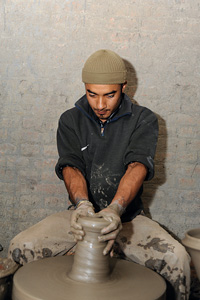One of the oldest forms of art, pottery continues in a much larger scale though many have discontinued the heritage of molding clay.
 Neither gold nor silver would make the man that god desired to create, our toothless grandmother would tell us when we were young. It was only when god used clay that the humane aspect of being a human was accomplished. And, our grandmother would conclude, that is why us, the clay-men, become a part of the earth when we die.
Neither gold nor silver would make the man that god desired to create, our toothless grandmother would tell us when we were young. It was only when god used clay that the humane aspect of being a human was accomplished. And, our grandmother would conclude, that is why us, the clay-men, become a part of the earth when we die.
Whether the story is true or not, whether we were made of clay or not, these hands have always had the glory of molding clay into desired shapes. Much before the glittery things got its prominence, clay used to possess a value that was impossible to measure in monetary forms. There is an interesting story on how people came up with the idea of using clay to make utensils.
Hari Prajapati, Nepal Field Director for Village Forward says that centuries ago when an elephant was playing in a pool of mud, it got covered in clay. When the mud in the elephant’s body dried, it began peeling off. When a giant piece of dried mud from the eleephant’s knee fell off, people began to notice its appropriate shape for using it as a utensil. The story continues further explaining how people got the idea to bake it. Sometime later, when fire consumed a house with a few clay pots, people noticed that fire actually strengthened the pottery rather than consuming them to ashes.
The pottery specimens recovered in Lumbini from the time of the Buddha suggests that Nepal has had a long history in pottery. Prajapatis, who primarily reside in Thimi, have been making pottery since times immemorial. It has been popular traditionally because it has no additive chemicals used in other products and has several added benefits too. Ratna Pratap Prajapati of Cera Nepal Udhyog says that he grew up in an environment where clay was food and happiness. He started playing with clay since he was fiv e. “I used to come back from school and would start making things out of clay,” he says. Earlier, agriculture and pottery went hand in hand. The produce in the farm would provide food for the family and the pottery would either be exchanged with goods or used for basic purposes at home. Ratna Pratap remembers how his father and brother would take the pottery to nearby hills like Sindhupalchowk and exchange them with eatables. Though this kind of exchange is no longer practiced, pottery is still gathering its remains.
e. “I used to come back from school and would start making things out of clay,” he says. Earlier, agriculture and pottery went hand in hand. The produce in the farm would provide food for the family and the pottery would either be exchanged with goods or used for basic purposes at home. Ratna Pratap remembers how his father and brother would take the pottery to nearby hills like Sindhupalchowk and exchange them with eatables. Though this kind of exchange is no longer practiced, pottery is still gathering its remains.
Traditionally, clay has been like flesh to the bones for the Newar community. The trad ition of serving rakshi to each guest in pyala – a clay vessel or storing water and local alcohol in gagri and ghyampo is still maintained in many homes in the Newar community.
ition of serving rakshi to each guest in pyala – a clay vessel or storing water and local alcohol in gagri and ghyampo is still maintained in many homes in the Newar community.
Most of the Prajapati families have now chosen different careers to support themselves. The reason could be the hard labor and extra efforts required in pottery, says Hari Prajapati. It has also been replaced by alternatives like plastic, glass and steel but pottery is evolving to find its roots. Although not traditional, products that address the demand of consumers like teliya itta (heat insulating bricks), water filters and decorative pieces are being manufactured by the younger generation of potters. The heritage of pottery making lives on although the process and products may have changed.
For more information: www.villageforward.org











